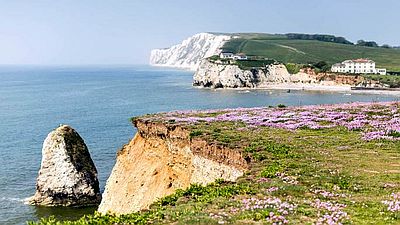Select units of measurement for the temperature and rainfall tables (metric or imperial).
Average weather, temperature, rainfall, sunshine hours
The climate of the Isle of Wight is
oceanic, with quite cold, rainy winters and mild, relatively rainy summers.
However, the south coast of England, where the Isle of Wight is located, has a mild and sunny microclimate, compared to the rest of Great Britain.
Wight is a small island located a short distance from the south coast of England, beyond the strait called
The Solent. However, it is the largest island in England, and the third largest in the United Kingdom after the two main islands (Great Britain and Ireland).
Winter is not very cold, but the sky is often cloudy, the humidity is high and there are periods when the wind blows moderate or strong. The rains are frequent.
Snow is rare, but can occasionally occur. On the coldest nights of the year, the temperature generally drops to around -2/-3 °C (27/28 °F °F), but can sometimes drop to lower values. At St Catherine's Point, the southernmost point of the island, the temperature reached -8 °C (17.5 °F) in February 1985, to -8.5 °C (16.5 °F) in January 1987, to -7.5 °C (18.5 °F) in February 1991, and to -5 °C (23 °F) in December 2010.
In
summer, temperatures are generally mild or cool. It can also rain, albeit a little less often than in winter.
Due to its coastal location, Wight is a little more sheltered from the heat waves that can sometimes affect the south east of England. However, hot periods cannot be ruled out, usually of short duration. The temperature reached 30 °C (86 °F) in June 1976 and 28.5 °C (83.5 °F) on other occasions.
In Shanklin, located on the southeastern coast of the island, the
average temperature of the coldest month (February) is of 5.9 °C (42.6 °F), that of the warmest month (August) is of 17.2 °C (63 °F). Here are the average temperatures.
Shanklin - Average temperatures (1991-2020) |
| Month | Min | Max | Mean |
|---|
| January | 3.9 | 8.5 | 6.2 |
|---|
| February | 3.4 | 8.4 | 5.9 |
|---|
| March | 4.5 | 10.3 | 7.4 |
|---|
| April | 6 | 12.9 | 9.4 |
|---|
| May | 8.8 | 15.8 | 12.3 |
|---|
| June | 11.5 | 18.4 | 14.9 |
|---|
| July | 13.6 | 20.5 | 17 |
|---|
| August | 13.8 | 20.5 | 17.2 |
|---|
| September | 12 | 18.5 | 15.3 |
|---|
| October | 9.7 | 15.2 | 12.4 |
|---|
| November | 6.6 | 11.7 | 9.1 |
|---|
| December | 4.5 | 9.3 | 6.9 |
|---|
| Year | 8.2 | 14.2 | 11.2 |
|---|
amounts to 870 millimeters (34.3 inches) per year: so, it is at an intermediate level. It ranges from 45 mm (1.8 in) in the driest months (June, July) to 115 mm (4.5 in) in the wettest (October). Here is the average precipitation.
Shanklin - Average precipitation| Month | Days |
|---|
| January | 105 | 13 |
|---|
| February | 75 | 11 |
|---|
| March | 60 | 10 |
|---|
| April | 55 | 9 |
|---|
| May | 50 | 8 |
|---|
| June | 55 | 8 |
|---|
| July | 50 | 8 |
|---|
| August | 65 | 8 |
|---|
| September | 70 | 9 |
|---|
| October | 115 | 13 |
|---|
| November | 120 | 14 |
|---|
| December | 120 | 14 |
|---|
| Year | 940 | 124 |
|---|
On average, there are around 1,925
sunshine hours per year: we are at the highest levels in Britain. Here are the average sunshine hours per day.
Shanklin - Sunshine hours| Month | Average | Total |
|---|
| January | 2.5 | 70 |
|---|
| February | 3.5 | 95 |
|---|
| March | 4.5 | 140 |
|---|
| April | 7 | 210 |
|---|
| May | 8 | 250 |
|---|
| June | 8.5 | 255 |
|---|
| July | 8.5 | 270 |
|---|
| August | 7.5 | 240 |
|---|
| September | 6 | 180 |
|---|
| October | 4 | 125 |
|---|
| November | 3 | 85 |
|---|
| December | 2 | 65 |
|---|
| Year | 5.3 | 1925 |
|---|
The
sea temperature ranges between 8 °C (46 °F) and 17 °C (63 °F). So, it never becomes warm for swimming. Here are the average sea temperatures.
Shanklin - Sea temperature| Month |
|---|
| January | 9.5 |
|---|
| February | 8.5 |
|---|
| March | 8.5 |
|---|
| April | 9.5 |
|---|
| May | 11 |
|---|
| June | 13.5 |
|---|
| July | 15.5 |
|---|
| August | 17 |
|---|
| September | 17 |
|---|
| October | 15.5 |
|---|
| November | 13.5"> |
|---|
| December | 11.5 |
|---|
| Year | 12.6 |
|---|

Best Time
The
best time to visit the Isle of Wight is the summer, from June to August, since it is the warmest of the year, although even in this season, it's better to bring a sweatshirt, a light jacket and an umbrella. The month of June is a bit cooler, so you may prefer July and August. September is a good month as well: it's a bit rainier than the summer months, but the temperatures are still pleasant, especially in the first part.
As previously mentioned, the
sea is very cool even in summer, however, on sunny days, when the breeze is not too cool, you can sunbathe.